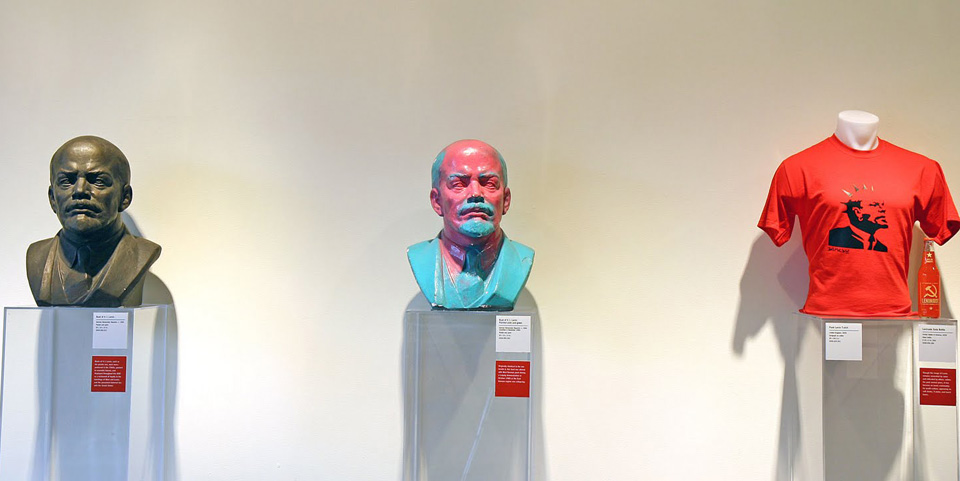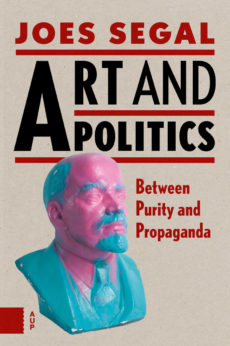
I learned the word reify back in the 1970s, I believe, a time when all my friends had posters of Che or Mao, Marx or Lenin on their walls. Social critics began observing that the mentality behind the display of such imagery had the effect to reify their ideas, to make a thing rather than a breathing, organic movement out of them. The word comes from Latin, and we know it in a phrase such as in re, meaning “in the matter of” or “concerning,” and in res publica, a “public thing,” or republic.
What the Dutch scholar Joes (pronounced yooss) Segal, now based in the Los Angeles area as chief curator of the Wende Museum of the Cold War in Culver City, has done in his new book Art and Politics: Between Purity and Propaganda, is to use several art-historical movements to debunk the reification of ideas that has set in about the relationship of art to societies of past and present. His command of ideas and sources is nothing short of magnificent, and nearly every page bursts with important, elegantly written and nuanced observations. Little that we thought we knew is left undisturbed by the new light he shines on his subjects.
Many art historians have followed the precept of critic Clement Greenberg that art inevitably moved away from the pictorial to the abstract in the 20th century as a means of expressing its “autonomy” divorced from the world external to the art-making process itself. “My thesis,” Segal writes, “is that any attempt to define a clear opposition between ‘political’ art on the one hand and ‘pure’ or ‘autonomous’ art on the other, is fundamentally flawed, because these are theoretical concepts that do not reflect historical reality.”
Nationalism, communism, enemies
His seven essays — apparently not previously published — begin with a contemplation of the art of World War I in both France and Germany. Our “reified” thinking about the art world in Europe of a hundred years ago turns toward Cubism, Expressionism, Dada, and the death of Romanticism. Yet Segal reminds us that the leading artists of France and Germany, far from being pacifists or internationalists, were instead seeking to define what “national” art meant, and to make derogatory claims about the “enemy” art coming from the other side. For many artists the war represented a welcome catharsis, a heroic purification, a decisive moment of recognition as to whose nation exclusively embodied culture and the higher spirituality.
Yet modernists in both countries were attacked by their own establishment critics as agents of enemy art, despite their professed patriotism. “It is a mistake to conclude,” Segal says, in phraseology that will ricochet throughout his book, “that because conservatives, nationalists, fascists, national-socialists and communists all hated modern art during large parts of the twentieth century, modern artists themselves were immune to ideological temptations.”
Segal takes up the case of Diego Rivera and Mexican muralism in his essay “Between Nationalism and Communism.” Rivera was a sometime member of the Mexican Communist Party, yet accepted generous commissions not only from anti-Communist governments at home, but also from rich American businessmen. He was expelled from the Soviet Union in 1928 for “anti-Soviet activities” as a member of the October art group, a collective that tried to thread a thin line between the avant-garde of the early years of the Russian Revolution and the empty propagandistic art of little distinction that began to dominate as Stalin consolidated his hold on the Soviet state.
Rivera inspired generations of American artists who saw his frescoes about modern industry at the Detroit Institute of Art. Segal seems puzzled by the question whether Rivera succeeded in merging, at least theoretically, the “mutually exclusive ideologies” of nationalism and communism — a problem that in a non-revolutionary epoch personally fails to excite me very much. “However,” Segal concludes, “Rivera was not an opportunist. He always remained loyal to his most fundamental principle: making art for the people, always the protagonists and positive hero of his work.”
Taking on the Third Reich in “National and Degenerate Art,” Segal takes special ironic pleasure in pointing out that the neat distinctions the Nazis tried to make between good and evil in art were often ignored either for political or personal reasons. Furthermore, the attempt to divide esthetic imagination and production into two clear, opposing camps led to similar efforts both in the Soviet Union and later in China, as well as on both sides in the Cold War period. In any case, mutually exclusive dichotomies could not always be drawn. Although criticized by the Nazi regime (but not by all of its leaders), some modern artists nevertheless continued to defend its policies.
The “Internal and External Enemies” chapter discusses the politics of art during the Cold War. Socialist nations promoted a realism, perhaps better a kind of hyper-realism, that emphasized the achievements of socialism so incomparably superior to the decadence of capitalism in the West. For its part, the West, then in the throes of a theoretically non-political modernism, advanced abstract art to demonstrate the artist’s complete freedom.
Yet there are contradictions to this neat paradigm. In the West there were plenty of conservatives who found no value in modern art, and especially no value worth government dollars to support; nor in any case did the general public broadly embrace abstraction as its preferred style. Those who embraced modernism as the badge of freedom and apolitical expression did not at all mind that this art was commandeered by the State Department to display abroad precisely for political purposes. And the Soviets found no problem honoring modern artists abroad, at international conferences and festivals, for example, whom they would never display in museums or galleries at home — such as Picasso, Fernand Léger and Renato Guttoso. Important voices in both systems identified modern art “as a subversive product of the ideological enemy.”
A propos, I am reminded of a funny incident that occurred in January 1985. I was working then for G. Schirmer, the noble old music publishing house, which represented the Soviet music agency for sales and performances in the U.S. Those mid-Reagan years were a bleak time in U.S.-Soviet relations, but interestingly enough a minor breakthrough came about with the New York Philharmonic’s performance of Sofia Gubaidulina’s Offertorium, with violinist Gidon Kremer. I invited my old friend and mentor, former Communist and copy editor for New Masses magazine, Betty Millard. The composition revealed a distinctly modern sensibility, not entirely atonal, but a difficult listen. When it concluded, Betty remarked, “You see, for years the Western critics would say that the Soviets can’t write contemporary music; now they can, and they write the same kind of music there that we can’t stand here either.”
What about non-Western art?
“From Maoism to Capitalist Communism” discusses the arc of art in the People’s Republic. Here, in writing about non-Western traditions, Segal proves himself an astute observer. One issue the Chinese Communists had to deal with after their assumption of state power in 1949 was Guohua, the esthetic in centuries-old Chinese art that emphasized harmony and inner spirituality, often expressed in the sole medium of black ink on paper. Must it all be abandoned in favor of socialist folk art? What was the effect of the cult of Mao? What damage, both temporary and lasting — and conceivably what success, depending on your point of view — was done by successive campaigns such as “Let a Hundred Flowers Bloom,” the Great Leap Forward, the Cultural Revolution, and the post-Mao liberalization? Each of these had its internal inconsistencies, and its opponents among the hierarchy.
Now there is a flourishing of art in China — it’s one of the hottest markets in the world, made possible precisely by the capitalization of many sectors in the country, although the Communist Party still holds the reins politically. Only in the occasional case of an internationally recognized artist such as Ai Weiwei do we see that the government does enforce certain boundaries beyond which art threatens to delegitimize the state. He is quoted as saying, “Art is a part of our total responsibility for the world. Otherwise I don’t see why we should make art.” He takes socialist utilitarianism and turns it on its head.
Segal’s sixth essay treats the “shadow murals” of African American artist Kara Walker, whose medium is paper cutouts, or silhouettes depicting African American history and society, class, gender and race. Walker has been criticized on the one hand for seemingly refusing to be universalist and ghettoizing her art, and on the other for employing racial stereotypes and attempting to appeal to white collectors. How much of an artist’s responsibility is “to conform to a status and normative sense of cultural identity and a sanctified version of collective history?” It would appear that there is almost an innate drive, not so dissimilar from official policy in totalitarian regimes, to divide art between “good” and “evil.” But who makes these determinations?
In a final essay, Segal reviews the fate of public art in post-socialist countries. What became of all those statues and monuments of socialist heroes? What replaced them? Did the post-Soviet regimes simply invent new role models for emulation? What part did the local populations play in these decisions? He refers to a Lenin bust, now in the collection of the Wende Museum, “that reportedly was spray-painted in pink and turquoise during a demonstration in the East German city of Leipzig in October 1989, a few weeks before the fall of the Berlin Wall… The demonstrators could have easily smashed the bust to make their point. Instead, by means of a simple intervention, they gave the founding father of Soviet communism a new meaning as the hopeful symbol of a more creative and joyful society.”
If you’re ready to de-reify your brain, read this.
Art and Politics; Between Purity and Propaganda
By Joes Segal
Amsterdam University Press, distributed by the University of Chicago Press, 2016
ISBN: 978 94 6298 178 2
165 pp., with notes, bibliography and index










